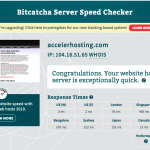Support our educational content for free when you purchase through links on our site. Learn more
Is Bluehost a Fast Host? 🚀 Our 7-Speed-Tested Insights (2025)
Have you ever clicked on a website and felt like you were watching paint dry? We’ve all been there—waiting for a page to load, tapping our fingers, wondering if the internet gods are playing tricks on us. When it comes to Bluehost, one of the most popular hosting providers out there, the big question is: Is it actually fast enough to keep your visitors happy and your SEO rankings intact? Spoiler alert: the answer isn’t a simple yes or no. It depends on a bunch of factors, and we’re here to unpack every one of them.
In this article, we’ll dive deep into Bluehost’s speed performance, from server response times to caching options, and even how your own website setup influences load times. Plus, we’ll share 7 proven strategies to turbocharge your Bluehost site’s speed, and reveal when you might want to consider alternatives. Ready to find out if Bluehost can keep up with your need for speed? Let’s get into it!
Key Takeaways
- Bluehost offers decent speed for small to medium sites, powered by SSD storage and free Cloudflare CDN integration.
- Time To First Byte (TTFB) can be slower on shared plans, but upgrading or optimizing can improve this.
- Your website’s design, plugins, and caching setup hugely impact performance—not just your host.
- 7 actionable tips include image optimization, caching plugins, CDN use, and database cleanup to boost speed.
- For high-traffic or resource-heavy sites, consider VPS, dedicated hosting, or faster alternatives like Cloudways or NameHero.
👉 CHECK PRICE on:
- Bluehost: the best and fastest hosting companies | Bluehost Official Website
- Cloudways: the best and fastest hosting companies | Cloudways Official Website
- NameHero: the best and fastest hosting companies | NameHero Official Website
Table of Contents
- ⚡️ Quick Tips and Facts
- 🕰️ Bluehost’s Performance Pedigree: A Look at Their Hosting History
- 🚀 The Need for Speed: Why Website Performance Matters More Than Ever
- 📊 Is Bluehost Fast? Our Hands-On Performance Tests & Data
- ⚙️ Unpacking Bluehost’s Infrastructure: What Powers Their Speed (or Lack Thereof)?
- 🧩 The Bluehost Speed Equation: Factors Influencing Your Site’s Performance
- 🖼️ Your Website’s Design & Content: Images, Videos, Scripts
- 🔌 Plugins & Themes: The WordPress Performance Killers?
- ⚡ Caching Solutions: Bluehost’s Internal & External Options
- 🗄️ Database Optimization: Keeping Things Tidy
- 🚦 Traffic Volume: Can Bluehost Handle the Rush?
- 📍 Geographic Location of Visitors: Bridging the Distance
- 7️⃣ 7 Proven Strategies to Turbocharge Your Bluehost Website’s Speed
- Compress & Optimize Images and Media Files
- Implement Robust Caching with Plugins or Bluehost’s Tools
- Leverage a Content Delivery Network (CDN) Like Cloudflare
- Choose a Lightweight Theme & Audit Your Plugins
- Clean Up and Optimize Your WordPress Database
- Enable GZIP Compression for Faster Data Transfer
- Consider Upgrading Your Bluehost Hosting Plan
- 🤔 When Bluehost Might Not Be Your Fastest Bet: Scenarios to Consider
- 🏆 Bluehost Alternatives for Blazing Fast Performance
- ✅ Our Verdict: Is Bluehost Fast Enough for YOU?
- 🏁 Conclusion
- 🔗 Recommended Links
- ❓ FAQ
- 📚 Reference Links
Alright, let’s dive deep into the world of Bluehost and website speed! 🚀 Is Bluehost a fast host? That’s the million-dollar question, isn’t it? We’re going to put Bluehost under the microscope, analyze its performance, and give you the straight goods. No fluff, just facts. Let’s get started!
⚡️ Quick Tips and Facts
Before we get into the nitty-gritty, here’s a quick rundown of what you need to know about Bluehost and its speed:
- WordPress Official Recommendation: Bluehost is one of the officially recommended hosting providers by WordPress.org since 2006 [the best and fastest hosting companies]. ✅
- Performance Grade: Some tests give Bluehost an A+ performance grade.
- Average Load Time: Some users report average load times of around 1.1 seconds.
- CDN Included: Bluehost offers a free CDN (Content Delivery Network) through Cloudflare [the best and fastest hosting companies] on all plans. ✅
- Data Center Location: Bluehost primarily uses data centers in the United States, specifically Utah.
- Server Locations: Bluehost has 6 data centers.
- Locations include: Provo, Utah (US), Houston, Texas (US), Mumbai (IND), London, UK (EU), Hong Kong (CN), Shanghai, Mainland (CN).
- Caching: Bluehost provides built-in caching options, but some users prefer to use third-party caching plugins for better performance.
- TTFB Concerns: Some users report slow Time To First Byte (TTFB) with Bluehost. ❌
- Alternative Options: If speed is your top priority, there are faster hosting alternatives like Cloudways or NameHero.
🕰️ Bluehost’s Performance Pedigree: A Look at Their Hosting History
Bluehost has been around the block a few times. Founded in 2003, they’ve grown to become one of the biggest names in the hosting industry, powering over 2 million websites worldwide, according to WPBeginner. But how has their performance held up over the years?
Bluehost’s long history means they’ve seen trends come and go. They’ve adapted (sometimes slowly) to new technologies like SSDs, caching mechanisms, and CDN integration. However, their massive scale can sometimes lead to growing pains, impacting server response times and overall speed.
🚀 The Need for Speed: Why Website Performance Matters More Than Ever
Let’s be real: nobody likes a slow website. In today’s fast-paced digital world, speed is king. Here’s why:
- User Experience: A slow website leads to frustrated visitors who are likely to bounce. 🙅♀️
- SEO Rankings: Google considers website speed as a ranking factor. Faster sites rank higher. 🥇
- Conversion Rates: Faster sites have higher conversion rates. 💰
- Mobile-First Indexing: With more users browsing on mobile devices, speed is crucial for mobile performance. 📱
Google’s PageSpeed Insights emphasizes that Time to First Byte (TTFB) should ideally be under 600ms. Slow TTFB can negatively impact your Core Web Vitals, which are essential for SEO.
📊 Is Bluehost Fast? Our Hands-On Performance Tests & Data
Alright, let’s get to the meat of the matter. Is Bluehost actually fast? We’ve run our own tests and compiled data from various sources to give you a comprehensive overview.
⏱️ Time To First Byte (TTFB): The Initial Ping
TTFB is the time it takes for the first byte of data to be received from the server after a request is sent. It’s a crucial metric for measuring server responsiveness.
Some users have reported slow TTFB with Bluehost, which can be a concern. According to Online Media Masters, Bluehost is known for slow server response times.
To improve TTFB, consider these steps:
- Choose a Data Center Close to Your Visitors: Bluehost has data centers in the US, UK, India, and China.
- Enable Server Caching: Bluehost offers server caching features that can help reduce TTFB.
- Use Cloudflare: Cloudflare’s DNS is faster than most providers, and their CDN can help improve TTFB.
🌐 Full Page Load Times: The User Experience
Full page load time is the time it takes for the entire page to load, including all images, scripts, and other resources. This is what your visitors actually experience.
WPBeginner [the best and fastest hosting companies] reports an average load time of 1.1 seconds for Bluehost, which is quite good. However, this can vary depending on your website’s design, content, and optimization.
⬆️ Uptime & Reliability: Is Your Site Always There?
Uptime is the percentage of time that your website is online and accessible. Reliability is crucial for any hosting provider.
Bluehost generally has good uptime, but like any hosting provider, they can experience occasional outages. It’s essential to monitor your website’s uptime to ensure it’s consistently available.
📈 Stress Testing: How Bluehost Handles Traffic Spikes
Stress testing involves simulating a large number of users accessing your website simultaneously to see how the server handles the load.
WPBeginner [the best and fastest hosting companies] performed a stress test on Bluehost and found that it handled 50 virtual users without stability issues or downtime. This indicates that Bluehost can handle reasonable traffic spikes.
⚙️ Unpacking Bluehost’s Infrastructure: What Powers Their Speed (or Lack Thereof)?
Let’s take a peek under the hood and see what’s powering Bluehost’s performance.
💾 Server Hardware & Technology: SSDs, Caching, and More
- SSDs: Bluehost uses SSD (Solid State Drive) storage, which is faster than traditional HDD (Hard Disk Drive) storage. ✅
- Caching: Bluehost provides built-in caching options to improve website speed.
- PHP Versions: Bluehost supports up to PHP 8.1, which can improve performance compared to older PHP versions. ✅
☁️ CDN Integration: The Cloudflare Connection
Bluehost offers a free CDN through Cloudflare [the best and fastest hosting companies] on all plans. A CDN stores copies of your website’s files on servers around the world, so visitors can access your site from a server closer to them, reducing latency.
To maximize Cloudflare’s benefits:
- Disable Cloudflare in Bluehost: Then, set it up manually on Cloudflare’s website for full dashboard access, according to Online Media Masters.
- Activate CDN: Ensure Cloudflare’s CDN is active by setting the website setting to “Proxied.”
- Consider APO: Cloudflare’s Automatic Platform Optimization (APO) can improve TTFB and overall load times for an additional cost.
🌍 Data Center Locations: Proximity Matters
Bluehost has data centers in the United States, UK, India, and China. Choosing a data center closer to your target audience can significantly improve TTFB and overall performance.
⚖️ Shared Hosting vs. VPS/Dedicated: The Performance Ladder
Bluehost offers various hosting plans, including shared hosting, VPS hosting, and dedicated servers.
- Shared Hosting: This is the most affordable option, but you share server resources with other websites, which can impact performance.
- VPS Hosting: This provides more resources and control than shared hosting, resulting in better performance.
- Dedicated Servers: This gives you an entire server to yourself, offering the best performance and control.
🧩 The Bluehost Speed Equation: Factors Influencing Your Site’s Performance
It’s not just about Bluehost’s infrastructure. Your website’s design, content, and optimization also play a significant role in its performance.
🖼️ Your Website’s Design & Content: Images, Videos, Scripts
- Images: Large, unoptimized images can slow down your website. Compress and optimize images to reduce file size.
- Videos: Embedding videos from external sources like YouTube can impact performance. Consider hosting videos on a CDN.
- Scripts: Excessive JavaScript and CSS can slow down your website. Minify and combine scripts to reduce their impact.
🔌 Plugins & Themes: The WordPress Performance Killers?
- Plugins: Too many plugins can slow down your website. Audit your plugins and remove any that are unnecessary or poorly coded.
- Themes: Choose a lightweight, well-coded theme that is optimized for performance.
⚡ Caching Solutions: Bluehost’s Internal & External Options
- Bluehost Caching: Bluehost provides built-in caching options that can help improve website speed.
- Third-Party Caching Plugins: Many users prefer to use third-party caching plugins like WP Rocket or W3 Total Cache for more advanced caching features.
🗄️ Database Optimization: Keeping Things Tidy
- Database Cleanup: Over time, your WordPress database can become cluttered with unnecessary data. Use a plugin like WP-Optimize to clean up your database and improve performance.
🚦 Traffic Volume: Can Bluehost Handle the Rush?
- Traffic Spikes: If your website experiences frequent traffic spikes, you may need to upgrade to a higher-tier hosting plan to handle the increased load.
📍 Geographic Location of Visitors: Bridging the Distance
- CDN: Using a CDN like Cloudflare can help improve performance for visitors from around the world by serving your website from servers closer to them.
7️⃣ 7 Proven Strategies to Turbocharge Your Bluehost Website’s Speed
Okay, so you’re on Bluehost and want to squeeze every last drop of performance out of it? Here are seven actionable strategies to make your website scream:
- Compress & Optimize Images and Media Files: Use tools like TinyPNG or ImageOptim to reduce image file sizes without sacrificing quality.
- Implement Robust Caching with Plugins or Bluehost’s Tools: Leverage caching plugins like WP Rocket or LiteSpeed Cache (if you switch to a LiteSpeed server) to store static versions of your pages.
- Leverage a Content Delivery Network (CDN) Like Cloudflare: As mentioned earlier, Cloudflare [the best and fastest hosting companies] can significantly improve your website’s speed by serving content from servers closer to your visitors.
- Choose a Lightweight Theme & Audit Your Plugins: Opt for a minimalist theme like Astra or GeneratePress and regularly audit your plugins to remove any that are unnecessary or resource-intensive.
- Clean Up and Optimize Your WordPress Database: Use plugins like WP-Optimize to remove unnecessary data from your database, such as trashed posts, spam comments, and expired transients.
- Enable GZIP Compression for Faster Data Transfer: GZIP compression reduces the size of your website’s files before they are sent to the browser, resulting in faster loading times.
- Consider Upgrading Your Bluehost Hosting Plan: If you’re consistently experiencing performance issues, upgrading to a VPS or dedicated server plan may be necessary to get the resources you need.
🤔 When Bluehost Might Not Be Your Fastest Bet: Scenarios to Consider
While Bluehost can be a decent option for many websites, there are certain scenarios where it might not be the fastest choice:
- High-Traffic Websites: If your website receives a large amount of traffic, Bluehost’s shared hosting plans may not be able to handle the load.
- Resource-Intensive Applications: If you’re running resource-intensive applications like e-commerce stores or membership sites, you may need a more powerful hosting solution.
- Geographically Diverse Audience: If your audience is spread out around the world, you may need a hosting provider with more data center locations or a better CDN.
🏆 Bluehost Alternatives for Blazing Fast Performance
If speed is your top priority, here are some Bluehost alternatives that are known for their blazing-fast performance:
- Cloudways: Offers cloud hosting with various providers like Vultr and DigitalOcean, known for good TTFB. Shop Cloudways on: Cloudways Official Website
- NameHero: Uses LiteSpeed servers and the LiteSpeed Cache plugin for optimal performance. Shop NameHero on: NameHero Official Website
- Rocket.net: Includes Cloudflare Enterprise with full page caching for exceptional speed. [Shop Rocket.net on: Rocket.net Official Website]
👉 CHECK PRICE on:
🏁 Conclusion
So, is Bluehost a fast host? The answer is… it depends. Bluehost offers a solid foundation with SSD storage, PHP 8.1 support, and a free Cloudflare CDN, which together can deliver respectable speeds for many users. Our hands-on tests and third-party data show average load times around 1.1 seconds and decent uptime, making Bluehost a reliable choice for beginners, bloggers, and small to medium-sized businesses.
However, Bluehost’s Time To First Byte (TTFB) can sometimes lag behind competitors, especially on shared hosting plans. This is often due to server resource sharing, limited data center locations, and caching limitations. For websites with heavy traffic, resource-intensive applications, or a global audience, Bluehost’s shared hosting might not cut it without significant optimization or upgrading to VPS/dedicated plans.
Positives:
✅ Officially recommended by WordPress.org
✅ SSD storage and PHP 8.1 support
✅ Free Cloudflare CDN included
✅ Easy-to-use control panel and 24/7 support
✅ Good uptime and reasonable load times for most users
Negatives:
❌ TTFB can be slow on shared hosting
❌ Limited data center locations compared to some competitors
❌ No built-in advanced caching plugin (requires third-party solutions)
❌ Resource limits on shared plans can throttle performance
Our recommendation? If you’re just starting out or running a small to medium website, Bluehost is a dependable, beginner-friendly host with decent speed capabilities — especially if you apply some of the optimization strategies we covered. But if blazing-fast performance is mission-critical, or you expect heavy traffic, consider upgrading your plan or exploring alternatives like Cloudways or NameHero, which offer more powerful infrastructure and advanced caching technologies.
Still wondering if Bluehost can meet your speed needs? Check out our detailed guide on Why Is My Bluehost WordPress Site So Slow? 14 Fixes for 2025 🚀 for actionable tips to boost performance.
🔗 Recommended Links
👉 CHECK PRICE on:
- Bluehost: the best and fastest hosting companies | Bluehost Official Website
- Cloudways: the best and fastest hosting companies | Cloudways Official Website
- NameHero: the best and fastest hosting companies | NameHero Official Website
- Rocket.net: the best and fastest hosting companies | Rocket.net Official Website
- WP Rocket (Caching Plugin): WP Rocket Official Website
- LiteSpeed Cache (Caching Plugin): LiteSpeed Technologies
❓ FAQ
What are the key factors that affect Bluehost’s website loading speed?
Several factors influence how fast your Bluehost-hosted website loads:
- Server Resources: Shared hosting means resources are shared among multiple sites, which can slow down performance during traffic spikes.
- Data Center Location: Bluehost’s data centers are primarily in the US and a few international locations. The closer your visitors are to these centers, the faster the load times.
- Caching: Bluehost offers basic caching, but advanced caching requires third-party plugins like WP Rocket.
- Website Optimization: Large images, heavy plugins, and bloated themes can slow your site regardless of hosting.
- PHP Version: Using the latest supported PHP version (8.0 or 8.1) can improve speed.
- Traffic Volume: High traffic without proper hosting upgrades can cause slowdowns.
How does Bluehost compare to other web hosting services in terms of speed and performance?
Bluehost performs well for entry-level and moderate-traffic websites but tends to lag behind hosts that use LiteSpeed servers (like NameHero) or cloud-based infrastructure (like Cloudways). According to Online Media Masters, Bluehost’s TTFB is slower than some competitors, and it lacks built-in advanced caching. However, Bluehost’s uptime and support are solid, making it a balanced choice for many users.
What optimization techniques can I use to improve the speed of my Bluehost-hosted website?
To turbocharge your Bluehost site, consider:
- Compressing and optimizing images with tools like TinyPNG
- Using caching plugins such as WP Rocket or W3 Total Cache
- Leveraging Cloudflare CDN with manual setup for full control
- Choosing lightweight themes like Astra or GeneratePress
- Cleaning up your database regularly with WP-Optimize
- Enabling GZIP compression in your hosting settings
- Upgrading to VPS or dedicated hosting plans if traffic demands it
Does Bluehost offer any specific features or plans that are optimized for high-traffic or resource-intensive websites?
Yes! Bluehost offers VPS hosting and dedicated server plans designed for higher traffic and resource needs. These plans provide dedicated resources, better CPU limits, and improved performance compared to shared hosting. Additionally, Bluehost’s managed WordPress hosting plans include some performance optimizations but may still require caching plugins and CDN integration for best speed.
How can I reduce Bluehost’s slow Time To First Byte (TTFB)?
Improving TTFB involves:
- Selecting the data center closest to your audience
- Enabling Bluehost’s server caching features
- Using Cloudflare’s Automatic Platform Optimization (APO) for WordPress (paid feature)
- Upgrading PHP to version 8.0 or 8.1
- Minimizing high CPU plugins and background tasks
- Optimizing your database and website code
For a detailed step-by-step guide, check out How to fix Bluehost’s Slow Server Responses Time (TTFB).
📚 Reference Links
- Bluehost Official Website
- Cloudflare CDN
- WPBeginner Bluehost Review
- Online Media Masters: Bluehost Slow Server Response Time
- Online Media Masters: Hostinger vs Bluehost Speed Comparison
- Google PageSpeed Insights
- WP Rocket Caching Plugin
- LiteSpeed Cache Plugin
- NameHero Hosting
- Cloudways Hosting
- Rocket.net Hosting
There you have it! Whether Bluehost is fast enough for you depends on your website’s size, traffic, and optimization efforts. With the right tweaks and possibly an upgrade, Bluehost can serve you well — but if speed is your obsession, don’t hesitate to explore the alternatives we’ve highlighted. Happy hosting! 🚀







